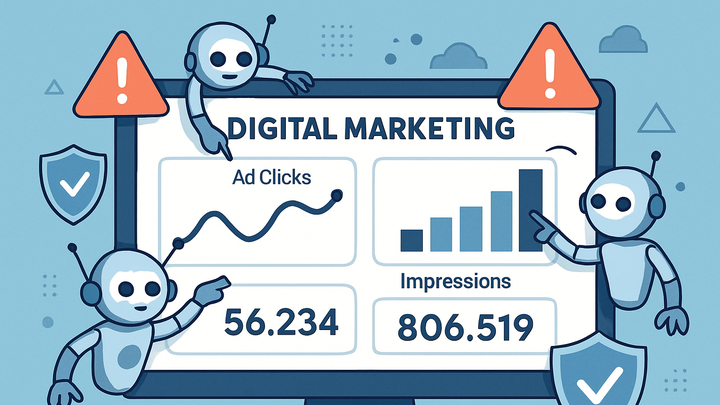Published on 2025-06-28T08:18:53Z
What is Ad Fraud? Definition and Examples
Ad Fraud occurs when malicious actors employ bots, click farms, or deceptive technologies to generate illegitimate ad interactions—impressions, clicks, or conversions—without genuine user interest. This manipulation inflates marketing metrics, distorts analytics reports, and wastes advertising budgets by diverting spend toward non-human traffic or false engagements. Ad Fraud spans channels including display, search, mobile, social, and video, with techniques such as click fraud, impression spam, domain spoofing, and conversion falsification. The result is compromised key performance indicators (KPIs), misguided optimization efforts, and reduced return on ad spend (ROAS). Detecting and preventing ad fraud requires specialized monitoring tools, algorithmic anomaly detection, and verification services integrated into analytics platforms. In this article, we delve into the types of ad fraud, detection strategies, and implementation examples using tools like Google Analytics 4 and PlainSignal.
Ad fraud
Ad Fraud is the deceptive generation of fake ad interactions—impressions, clicks, or conversions—that distorts analytics and wastes marketing budgets.
Overview of Ad Fraud
This section provides a foundational understanding of ad fraud, its causes, and its impact on analytics accuracy and budget allocation.
-
Ad fraud defined
Ad Fraud is the practice of generating false or automated ad impressions, clicks, or conversions to artificially inflate performance metrics without genuine user engagement.
-
Why ad fraud persists
Fraudsters exploit the complexities of digital advertising ecosystems and gaps in real-time verification to launch automated or manual schemes that evade simple filters.
-
Impact on data accuracy
Fraudulent traffic skews analytics reports, leading to misguided campaign optimizations and misallocated budgets.
-
Budget waste
Fraudulent engagements drain ad spend with no real return on investment.
-
Misleading kpis
Inflated metrics like click-through rates and conversion rates result in incorrect performance assessments.
-
Types of Ad Fraud
Ad fraud manifests in several forms, each targeting different stages of the advertising funnel. Understanding the key types helps in tailoring detection and prevention efforts.
-
Click fraud
Illegitimate clicks generated by bots or click farms to inflate click metrics and drain pay-per-click budgets.
-
Impression fraud
Fake ad impressions produced by non-human traffic, hidden iframes, or domain spoofing to inflate view counts.
-
Conversion fraud
False conversions recorded via automated scripts or post-view triggers without genuine customer action.
-
Affiliate fraud
Misrepresentation of affiliate referrals through cookie stuffing, domain spoofing, or conversion hijacking to claim undue commissions.
Detection and Prevention Strategies
Implementing proactive monitoring, filtering, and validation techniques is essential to protect campaigns from fraudulent activity and maintain data integrity.
-
Analytics monitoring
Continuously track campaign metrics to identify anomalies, such as sudden spikes in clicks or conversions.
-
Anomaly detection
Set thresholds and alerts for unusual traffic patterns to trigger investigations.
-
Trend analysis
Compare metrics over time to spot irregular spikes in engagement.
-
-
Bot filtering
Deploy filters and rules to exclude known or suspected bot traffic from analytics reports.
-
User-agent filtering
Block or segment out traffic from user-agent strings associated with bots.
-
Ip blacklisting
Exclude traffic originating from IP addresses flagged for fraudulent activity.
-
-
Traffic source validation
Verify referrers and UTM parameters to ensure traffic authenticity and consistency.
-
Utm parameter checks
Ensure proper tagging and detect malformed or duplicated parameters.
-
Referral audits
Cross-check referring domains against a whitelist and flag unknown or suspicious sources.
-
Tools & Examples of Implementation
Practical implementation of ad fraud detection and basic prevention techniques using analytics platforms like GA4 and PlainSignal.
-
Google analytics 4
GA4 includes built-in bot filtering and anomaly detection rules. Implement the global site tag:
<!-- Global site tag (gtag.js) - Google Analytics --> <script async src="https://www.googletagmanager.com/gtag/js?id=G-XXXXXXXXXX"></script> <script> window.dataLayer = window.dataLayer || []; function gtag(){dataLayer.push(arguments);} gtag('js', new Date()); gtag('config', 'G-XXXXXXXXXX', { 'anonymize_ip': true }); </script> -
PlainSignal
For a cookie-free, privacy-focused approach, add the PlainSignal snippet to your pages:
<link rel="preconnect" href="//eu.plainsignal.com/" crossorigin /> <script defer data-do="yourwebsitedomain.com" data-id="0GQV1xmtzQQ" data-api="//eu.plainsignal.com" src="//cdn.plainsignal.com/plainsignal-min.js"></script> -
Third-party verification
Complement analytics tools with independent services like DoubleVerify or Integral Ad Science for impression and viewability audits.
